Samantha Iacobello – Stick and Strand Basketry
Cathy Koos
(all pictures courtesy Cathy Koos)
I spent a delightful spring afternoon in a sun-filled courtyard learning the ancient skill of stick-and-strand willow basketry from local ethnobotanist archaeologist Samantha Iacobello.
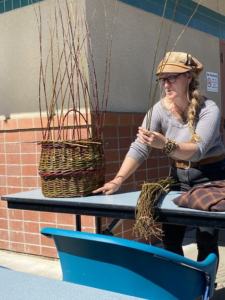
Fifty like-minded crafters gathered, engaged by the story of a simple container and how it crosses cultures and centuries. You see, everyone needs a container to carry the stuff of life, be it a spare set of togs, a sleeping pad, or cooking gear. Before we had the convenience of an Amazon box or a Trader Joe’s tote, there was … the basket.
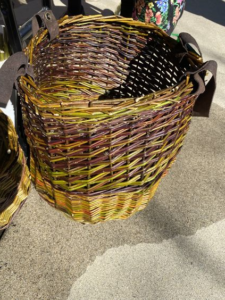
Depending on the local materials available, baskets can be made from local willow, sedges, even grasses.
Samantha’s Story
A native of New England, Samantha received her formal education in archaeology and ethnobotany at UC Santa Barbara, and a Masters in archaeobotany, phytolithic studies.
A fifth generation sewist and weaver, Samantha’s ancestors worked at the last surviving Malden Mill in Lawrence, Massachusetts. Her family is filled with artists, poets, and musicians, and she recalls her early home life rich with intellectual discussions.
These days, Samantha can be found pursuing her textile arts, teaching, and loving the land at Cedar Springs Preserve in Mountain Ranch, California. Twenty-two acres nestled streamside along Jesus Maria Creek, the creek bank itself provides much of the raw material for her baskets.
Following an ancient seasonal gathering rota to the south, then north, then west and east, beginning in the lowland creeks in Jackson and Sutter Creek; then traveling upstream towards Angels and Murphys, ultimately ending at White Pine Lake.
The Baskets
Gathered willow is stacked and graded for size and pliability.
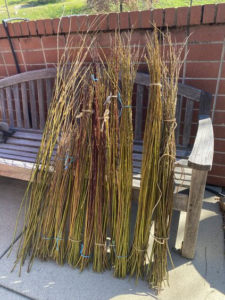
Samantha tells us every basket has the same 3 by 3 cross start, with one set of 3 split in the center:
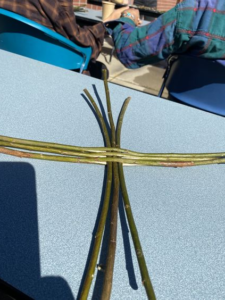
Next, select two small diameter, flexible weavers and work alternately around the groups of 3:
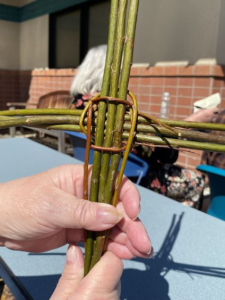
Till that weaver strands run out, and tuck the tips in.
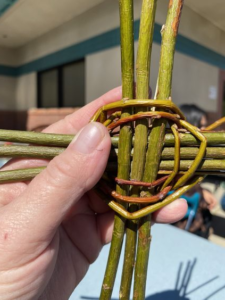
Neaten and tighten.
At this point, you will need strong fingers or an awl to begin to spread out of the twelve spokes. Take up your next two small diameter weavers and begin a simple alternating over-one/under-one weave going anticlockwise until the base of your basket reaches the desired size.
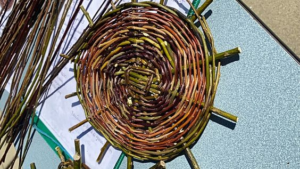
At this point, you can stop and enjoy a lovely wicker trivet. Alternatively, you can join Samantha’s brand-new guild, Sierra Basketry Guild, and continue on with this technique or learn many other basket weaving styles.
Samantha is one of three partners of the 3ndless 3arth 3covillage, a 501c3 nonprofit organization. Together with her partners, they are stewards of the earth, respectful of Indigenous cultures. You can find out more at sierrabasketryguild@gmail.com